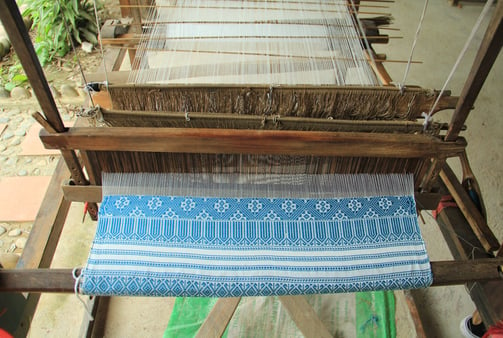The main techniques to create brocade patterns
Each Vietnamese ethnic group has different methods, techniques, and secrets to create colorful and meaningful Tho Cam panels.
Often associated with the costumes of highland women, brocade patterns are a unique cultural feature of the Vietnamese ethnic community. Before industrial fabrics and chemical dyes were widely used, the creation of brocade patterns was done manually using techniques passed down through generations.
Batik technique: This technique is commonly used among H'Mong and Dao Tien people. People draw patterns with beeswax by dipping paint brushes in melted beeswax and then drawing patterns on rustic cloth. The beeswax will stick to the fabric, then the fabric is dyed indigo several times until it has the desired color. Where beeswax is drawn, the indigo water will not penetrate. After washing and drying, people melt the beeswax away so that the beeswax adheres to the fabric, creating white patterns on the dark indigo fabric. In addition, they also print beeswax by using molds with carved decorative motifs and then dipping in heated beeswax and stamping on rustic fabrics.
Embroider: Embroidery is a popular technique in the northern mountainous ethnic groups because women can carry their clothes with them and embroider anywhere: at home, in the fields, when going to the market, or going out. Girls learn to embroider at a very early age and by the age of 12-13 have mastered embroidery. Embroidery techniques are applied to many types of brocade patterns
With embroidery techniques, one can create natural curves. The H'mong cross-stitch their noses to create multiplication marks. The Dao and Thai people mainly use embroidery and threading techniques. Traditional embroidery patterns are memorized and passed down from generation to generation.
Fabric folding technique: Popular among some ethnic groups in the northern mountainous region, cloth knitting is a technique of creating patterns with many small colored cloths sewn on a background cloth. The landing fabric has different colors, and is cut in triangles, squares, and rectangles ... then sewn on the base fabric, the stitches are hidden on the back without revealing the thread.
Each ethnic group often has its own grafting patterns. The Lo Lo and Pu Peo people put together triangles. The H'mong have a very sophisticated technique of landing cloth called "reverse cloth landing", that is, a piece of cloth is cut into patterns and then landed on clothes to reveal the background color below.
Ikat. In the technique of ikat or "dyeing the yarn", people use bark fibers or nylon fibers to wrap around the fiber bundles in different sections and then dye them. Wrapped yarn sections will not stain. The process of wrapping-dyeing is repeated many times to create multicolored, dark, and light yarns, used as weft to weave ikat fabric.
Weaving. With the weaving technique, to create a pattern, one adds a weft that is distinct from the base yarn. This additional weft is inserted between the warp lanes by two different techniques: either the yarn runs across the width of the fabric, or just where it is intended for decoration.
The weaver works on the reverse side of the fabric. Weaving looms can be large, foot-operated looms, such as those of the Thai, Muong, or the "Indonesian" type of the ethnic groups in the Central Highlands. These looms have two basic rows of spools and side spools or small rods that separate the warp to insert the extra weft to create a pattern. The more complex the pattern, the greater the number of sub-gos that need to be used


Address
101 Block B, Tran Quoc Thao Apt, Ward 9, Distric 3, HCM City
Contacts
M: 0888320809
E: thocampieu@gmail.com
